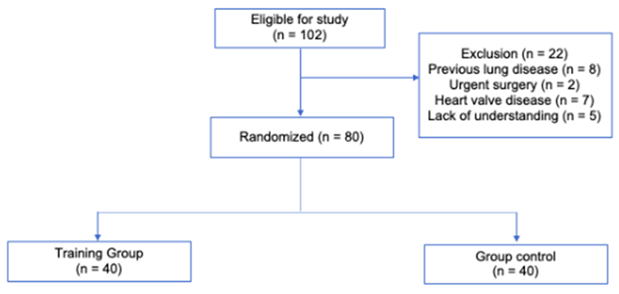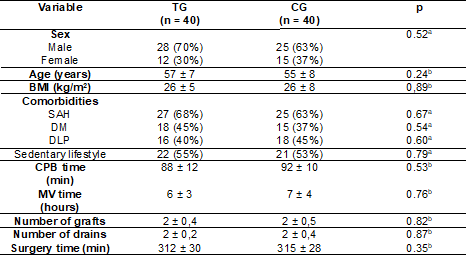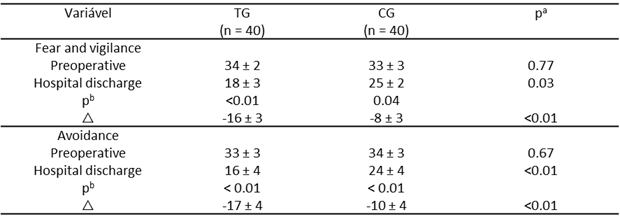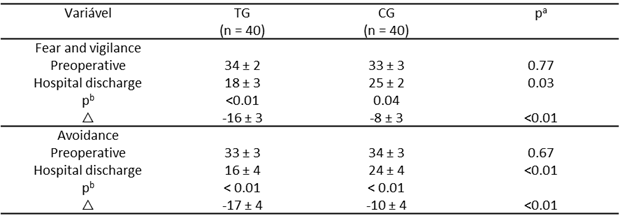Rev Bras Fisiol Exerc. 2024;23(2):e235595
doi: 10.33233/rbfex.v23i2.5595ORIGINAL ARTICLE
Inspiratory muscle training reduces heart anxiety in patients submitted to
coronary artery bypass grafting: Controlled randomized clinical trial
Treinamento muscular
inspiratório reduz a ansiedade cardíaca em pacientes submetidos à cirurgia de
revascularização do miocárdio: ensaio clínico randomizado controlado
André Luiz Lisboa Cordeiro1,2,
Hayssa de Cássia Mascarenhas Barbosa1,2,
Lucas Oliveira Soares2, Thiago Araújo de Melo3, Franciele
Almeida2, Erivelton Araújo2, André Raimundo Guimarães4,
Jefferson Petto1,5,6
1Escola Bahiana de Medicina e Saúde
Pública, Salvador, BA, Brazil
2Faculdade Nobre, Feira de Santana, BA, Brazil
3Universidade Salvador, Salvador, BA, Brazil
4Instituto Nobre de Cardiologia, Feira de
Santana, BA, Brazil
5Universidade Salvador, Feira de Santana,
BA, Brazil
6Faculdade Adventista da Bahia,
Cachoeira, BA, Brazil
Received: May 8, 2024; Accepted:
June 10, 2024.
Correspondence: André Luiz Lisboa Cordeiro, andrelisboacordeiro@gmail.com
How to cite
Cordeiro ALL, Barbosa HCM,
Soares LO, Melo TA, Almeida F, Araújo E, Guimarães AR, Petto J. Inspiratory muscle training reduces heart anxiety
in patients submitted to coronary artery
bypass grafting: Controlled randomized clinical trial. Rev Bras Fisiol
Exerc. 2024;23(2):e235595. doi:10.33233/rbfex.v23i2.5595
Abstract
Introduction: Cardiac anxiety (CA) is a common finding in patients
undergoing preoperative and postoperative care for coronary artery bypass
grafting (CABG). Inspiratory muscle training (IMT) aimed at increasing muscle
strength may reduce CA in the postoperative period. Objective: to verify
whether IMT reduces cardiac anxiety in patients undergoing myocardial
revascularization and whether there is a correlation between inspiratory muscle
strength and cardiac anxiety. Methods: This is a controlled and
randomized clinical trial. In the preoperative phase, all patients completed a
cardiac anxiety questionnaire, which included two domains: fear and vigilance
and avoidance. Additionally, maximum inspiratory pressure (MIP) was assessed.
After the surgical procedure, patients were divided into a control group (CG)
that received routine hospital care and a training group (TG) that underwent an
IMT protocol until hospital discharge. Results: Eighty patients were
evaluated. The IMT group showed a 17% decrease in MIP, while the CG experienced
a 43% decrease (p < 0.01). The fear and vigilance domain showed a reduction
of -16±3 in the CG, while the TG had a reduction of -8 ± 3 (p < 0.01).
Furthermore, a strong correlation was found between MIP in the TG and the
domains of fear/vigilance (r -0.77) and avoidance (r -0.72). Conclusion:
IMT is associated with a reduction in the loss of inspiratory muscle strength,
resulting in a lower level of cardiac anxiety in patients undergoing coronary
artery bypass grafting.
Keywords: cardiac surgery; exercise; anxiety
Resumo
Introdução: A ansiedade cardíaca (AC) é um achado
comum em pacientes no pré e pós-operatório de cirurgia de revascularização do
miocárdio (CRM). O treinamento muscular inspiratório (TMI) para gerar aumento
da força muscular pode causar diminuição da AC no pós-operatório. Objetivo:
verificar se o TMI diminui a ansiedade cardíaca de pacientes submetidos à
revascularização do miocárdio e se existe correlação entre força muscular
inspiratória e ansiedade cardíaca. Métodos:
Trata-se de um ensaio
clínico controlado e randomizado. No momento
pré-operatório, todos os pacientes
responderam a um questionário de ansiedade cardíaca,
composto por dois
domínios: medo e vigilância e evitação.
Além disso, foi avaliada a pressão inspiratória
máxima (PImáx). Após o procedimento cirúrgico, os pacientes foram
divididos em um grupo controle (GC) que recebeu cuidados hospitalares de rotina
e um grupo de treinamento (GT) que foi submetido a um protocolo de TMI até o
momento da alta hospitalar. Resultados: Foram avaliados 80 pacientes. O
grupo TMI apresentou uma diminuição de 17% na PImáx enquanto o GC
diminuiu 43% (p < 0,01). O domínio medo e vigilância teve uma redução de -16
± 3 no GC enquanto no GT a redução foi de -8±3 (p < 0,01). Para além disso,
verificou-se uma forte correlação entre a PImáx do TG com os
domínios do medo/vigilância (r -0,77) e evitamento (r -0,72). Conclusão:
O TMI está associado a uma redução na perda de força muscular inspiratória,
resultando em um nível reduzido de ansiedade cardíaca em pacientes submetidos à
cirurgia de revascularização do miocárdio.
Palavras-chave: cirurgia cardíaca; exercício;
ansiedade
Coronary artery bypass grafting (CABG) has improved
quality of life for patients with coronary heart disease [1], but despite
continuous innovations and improvements in the quality of interventions, the
surgical procedure is still a difficult time for the patient and also for his
family. The high complexity of the procedure can cause stress, anxiety and
depression as the main neuropsychological manifestations [2,3].
In addition to being associated with the high rate of
recurrences, death and prolonged hospitalization, anxiety and depression can
lead to poor prognosis and are associated with psychological stress that
affects the health of patients undergoing cardiac surgery [3]. Several studies
have highlighted the importance of assessing psycho-emotional stressors in
patients before and after myocardial revascularization. As an example, high
levels of anxiety are associated with depression, which negatively affects physiological
parameters and influences patient recovery in several factors [4].
Cardiac anxiety (CA) is defined as an unpleasant
emotional state or condition with experiential, physiological and behavioral
components [5]. The clinical manifestation of CA is agitation and
disorientation, and these changes can lead to increased heart rate, respiratory
rate, and blood pressure [5,6]. CA may remain elevated in the postoperative
period due to factors such as poor nursing care during this period and the
ventilatory restriction generated by pain and reduced muscle strength caused
mainly by median sternotomy and surgical manipulation [6,7]. Inspiratory Muscle
Training (IMT) is therefore an alternative to reduce the loss of ventilatory
muscle strength and, consequently, eliminate the stressor and limiting factor
that is ventilatory muscle weakness [8,9]. In IMT a load is applied against
muscle activity. Due to the overload generated in the muscle, there will be an
increase in muscle strength [9].
Several studies use IMT as an instrument to optimize
outcomes such as functional capacity, length of hospital stay and postoperative
pulmonary complications [9], however, there is a knowledge gap about the impact
of IMT on cardiac anxiety. Therefore, the aim of this study was to assess the
impact of IMT on inspiratory muscle strength and its relationship to cardiac
anxiety in patients undergoing myocardial revascularization.
Methods
This randomized controlled clinical trial was carried
out at a referral hospital
in cardiology in the city of Feira de Santana, Bahia, Brazil from February
to November 2018. It was
approved by the Research Ethics Committee of Faculdade Nobre de Feira de
Santana under the number 2.366,995 and is found in the Brazilian Registry of
Clinical Trials (ReBEC) under number RBR-8dqrdq. All participating patients
signed a Free and Informed Consent Form.
Patients
The criteria were analyzed in the preoperative period,
when patients were admitted to the hospital. Patients of both sexes aged
between 30 and 70 years, who underwent myocardial revascularization with
extracorporeal circulation and median sternotomy were included. Patients were
excluded if they had valvular heart disease, previous lung disease, death,
inability to understand how to perform the inspiratory muscle strength
assessment, presented hemodynamic instability (mean arterial pressure below 70
mmHg or above 110 mmHg and / or heart rate below 60 or above 120 beats per
minute) during assessment or inspiratory muscle training, inability to answer
the heart anxiety questionnaire and emergency surgery.
Assessment of cardiac anxiety
In the preoperative period and at hospital discharge, all
patients answered a cardiac anxiety questionnaire in a version validated for
Portuguese by Sardinha et al. [10] applied by a blind examiner regarding
the allocation process of the groups. This scale has 18 items, distributed in
two domains - fear and hypervigilance and avoidance, with responses ranging
from 0 (never) to 4 (always). Patients respond about heart-related fear (8
items, e.g. "I worry that I might have a heart attack" and "If
the test comes out normal, I still worry about my heart") and avoidance (5
items, e.g. "I take it easy as much as (5 items, e.g. "I check my pulse").
Higher scores reflect greater cardiac anxiety.
Measurement of ventilatory muscle strength
The ventilatory muscle strength was determined by
assessing maximum inspiratory pressure (MIP) using an analog manovacuometer
(Indumed®, Brazil) in the preoperative period in both groups. The measurement
was performed according to the protocol evaluated by Neder et al. [11],
which uses a unidirectional valve coupled to the manovacuometer and a nozzle
with a 1mm millimeter orifice. The participant was asked to perform a maximum
exhalation up to the residual volume and then a maximum and slow inhalation
until the total lung capacity. The measurements were repeated three times, with
an interval of one minute between them, using the highest value reached,
provided that this value was not the last [10]. Evaluation of muscle strength
and cardiac anxiety were checked preoperatively and at the time of hospital
discharge.
Inspiratory muscle training
After the surgical procedure, the patients were referred
to the Intensive Care Unit (ICU) and received care according to the
institution's protocol. On the first postoperative day, patients were
randomized and performed the procedures according to the allocation groups:
Inspiratory Muscle Training Group (TG). Patients underwent inspiratory muscle
training with a linear pressure load device (PowerBreathe Knectic Series®, HaB
International, UK), with a load equivalent to 40% of the MIP, performing 3
series with 15 repetitions [8]. This training was carried out twice a day,
until the day of hospital discharge in association with the usual care of the
physiotherapy team.
Control Group (CG) - Patients were managed exclusively according to the
usual routine, which consists of applying non-invasive ventilation, breathing
exercises, kinesiotherapy, cycle ergometry and stimulating walking.
Statistical analysis
Data analysis was performed using SPSS version 20.0. The
Shapiro-Wilk test was used in order to determine the standard of data
normality. Quantitative variables were expressed as mean and standard
deviation, intra-group comparison of preoperative values with values obtained
at hospital discharge were performed using the paired Student t test, and the
independent Student t test for inter-group analyzes. Spearman's test was used
to correlate the muscle strength variable with the cardiac anxiety outcome. P
< 0.05 was considered significant.
Results
The flowchart for selecting patients included in the
study is shown below (Figure 1). The groups showed homogeneity in the
preoperative period, with no statistically significant differences, both for
demographic and clinical variables (Table I). During the research period, no
patient who underwent inspiratory muscle training experienced adverse events.
The group that performed the inspiratory muscle training
showed a 17% drop in inspiratory muscle strength while the control group showed
a 43% decrease (p < 0.01) (Table II). The TG patients remained hospitalized
for 6 ± 2 days against 9 ± 3 days in the CG (p = 0.04), totaling an average of
13 ± 4 sessions of IMT during the hospital stay.
The variation in cardiac anxiety (Table III) was greater
in the training group when compared to the control group, both in the fear and
vigilance and avoidance domains (p < 0.01).
Table IV shows the correlation between the variation in
inspiratory muscle strength in absolute value and the two domains of cardiac
anxiety. We noted that improved muscle strength was associated with decreased
anxiety in the patients studied.

Figure 1 - Flow chart of patients' progression during the
study
Table I - Demographic, clinical and surgical characteristics
of the patients studied

aChi-square; b Independent
Student T test; BMI = Body Mass Index; SAH = Systemic Arterial Hypertension; DM
= Diabetes Mellitus; DLP = Dyslipidemia; CPB = Cardiopulmonary bypass; MV =
Mechanical Ventilation
Table II - Behavior of Inspiratory Muscle Strength between the
groups studied

aIndependent Student T
test; bPaired Student's t-test; MIP - Maximum Inspiratory Pressure; △ = preoperative value subtracted from hospital discharge
value
Table III - Behavior of Cardiac Anxiety among the groups
studied

andependent Student T test;
bPaired Student's t-test; △ = preoperative value subtracted from hospital discharge value
Table IV - Correlation between absolute variation in
inspiratory muscle strength and cardiac anxiety domains

*Spearman test; MIP = Maximum Inspiratory Pressure
Discussion
Based on the findings, it can be suggested that the
increase in inspiratory muscle strength, through inspiratory muscle training,
was associated with decreased levels of cardiac anxiety in patients undergoing
myocardial revascularization.
Anxiety and depression are interdependent variables and
several studies have already shown a reduction in the intensity of these
conditions in patients undergoing cardiac surgery exposed to physical exercise
[5,12,13]. However, no studies were found to determine the impact of
inspiratory muscle training on cardiac anxiety in this population.
A possible explanation for this result is the increase in
levels of the brain-derived neurotrophic factor (FNDC), mainly in the
hippocampus region [14], the FNDC is of fundamental importance for the learning
and consolidation of memory, which in turn, are responsible for the long-term
effects of environmental stimuli as stressful life events [15]. Broman-Fulks
and collaborators demonstrated a decrease in the self-reported feeling of fear
or anxiety in patients undergoing an aerobic exercise program [16].
Another possibility for reducing anxiety is the increase
in cerebral neurogenesis, which can be obtained through physical exercise. To
achieve this change in brain structure, some conditions are associated, such
as: increased endorphin B, vascular endothelial growth factor, FNDC and
serotonin [14].
In addition, Bettencourt et al. [17] report that the
ability to exercise has a direct influence on anxiety and depression. The
greater the capacity to perform activities, the lower the cardiac anxiety.
Patients undergoing cardiothoracic surgery tend to have reduced physical
capacity in the postoperative period [8,9] and that IMT is a tool to increase
functional capacity. Thus, the reduction in anxiety found in our study may have
been influenced by the increase in functional capacity secondary to muscle
training.
Tamuleviciute-Prasciene et al. [18] concluded in
their literature review that physical exercise enhances clinical and functional
outcomes such as increased strength and muscle mass, mobility, cognition,
activities of daily living and reduced anxiety. Most of these studies address
aerobic exercises as part of phase I rehabilitation, in our study we increased
the protocol with the IMT, achieving encouraging results.
During IMT there is a reduction in the diaphragmatic
metaborreflex, generating a greater blood supply to appendicular muscles, thus
improving performance in activities [13,19], increasing the self-esteem of
these patients, causing a reduction in cardiac anxiety.
A study entitled EUROASPIRE III demonstrated that regular
physical exercise is associated with decreased levels of anxiety and depression
in patients with coronary artery disease [20]. A similar result was found by
Zheng et al. [21], but in patients after acute myocardial infarction.
Pain related to the presence of drains and surgical
incision leading to the avoidance of certain activities such as coughing,
taking deep breaths and physical activity [22], can generate a reduction in
ventilatory muscle strength, thus increasing cardiac anxiety.
Another form of anxiety control resides in the pre and
postoperative guidelines. It is based on the possibility of informing the
patient what will happen during the entire operative period that extends from
hospital admission to discharge home. These guidelines, in addition to reducing
anxiety, are linked to improved quality of life, self-report, functional
capacity and postoperative complications [6,7]. Orienting and making the
patient aware of the need and benefits of inspiratory muscle training is of fundamental
importance.
According to our knowledge, this is the first study that
correlates the direct impact of IMT on cardiac anxiety in patients undergoing
CABG, therefore, we cannot consider that training was the main contributor to
reducing the outcome variable.
Some limitations can be pointed out: (1) lack of sample
calculation; (2) non-stratification for risk factors such as age, surgical risk
and comorbidities; (3) not applying a pain scale, although all patients have
protocol-guided analgesia.
Conclusion
Inspiratory
muscle strength is strongly associated with cardiac anxiety in the
postoperative period of myocardial revascularization and inspiratory
muscle training is capable of reducing cardiac anxiety in this
population.
Conflict of interest
The authors declare that there is no conflict of
interest.
Sources of financing
There was no funding.
Authors' contributions
Conception and design of the research: Cordeiro ALB; Data collection: Cordeiro ALB, Almeida F, Araújo E; Data
analysis and interpretation: Cordeiro ALB, Barbosa HCM, Jefferson Petto J;
Statistical analysis: Cordeiro ALB, Petto J; Manuscript writing:
Cordeiro ALB, Barbosa HCM, Soares LO, Almeida F, Araújo E, Petto J; Critical
review of the manuscript: Melo TA, Guimarães AR, Petto J
References
- Kazitani BS, Furuya RK, Dantas RAS, Dessotte CAM. Preoperative anxiety and
depression: differences among patients submitted to the first cardiac surgery.
Rev Rene. 2018;19:e3079. doi: 10.15253/2175-6783.2018193079 [Crossref]
- Tully PJ, Newland RF, Baker RA. Cardiovascular risk profile before coronary artery bypass graft surgery in relation to depression and anxiety disorders: an age and sex propensity matched study. Aust Crit Care. 2015;28(1):24-30. doi: 10.1016/j.aucc.2014.04.006 [Crossref]
- Cordeiro ALL, Freire L,
Mendes R, Bastos A, Carvalho S, Guimarães AR. Aplicação do questionário de
ansiedade cardíaca no pós-operatório de cirurgia cardíaca. RBPFEX.
2015;9(56):592-6. [cited 2023 Nov 12]. Available from:
https://www.rbpfex.com.br/index.php/rbpfex/article/view/812
- Rodrigues HF, Furuya RK, Dantas RAS Dessotte CAM. Ansiedade e depressão em cirurgia cardíaca: diferenças entre sexo e faixa etária. Esc Anna Nery 2016;20(3):e20160072. https://doi.org10.5935/1414-8145.20160072 [Crossref]
- Wegner M, Helmich I, Machado S, Nardi AE, Arias-Carrion O, Budde H. Effects of exercise on anxiety and depression disorders: review of meta- analyses and neurobiological mechanisms. CNS Neurol Disord Drug Targets. 2014;13(6):1002-14. doi: 10.2174/1871527313666140612102841 [Crossref]
- Guo P. Preoperative education interventions to reduce anxiety and improve recovery among cardiac surgery patients: a review of randomized controlled trials. J Clin Nurs. 2015;24(1-2):34-46. doi: 10.1111/jocn.12618 [Crossref]
- Kalogianni A, Almpani P, Vastardis L, Baltopoulos G, Charitos C, Brokalaki H. Can nurse-led preoperative education reduce anxiety and postoperative complications of patients undergoing cardiac surgery? Eur J Cardiovasc Nurs. 2016;15(6):447-58. doi: 10.1177/1474515115602678 [Crossref]
- Cordeiro AL, Melo TA, Neves D, Luna J, Esquivel MS, Guimarães AR, et al. Inspiratory muscle training and functional capacity in patients undergoing cardiac surgery. Braz J Cardiovasc Surg. 2016;31(2):140-4. doi: 10.5935/1678-9741.20160035 [Crossref]
- Gomes Neto M, Martinez BP, Reis HF, Carvalho VO. Pre- and postoperative inspiratory muscle training in patients undergoing cardiac surgery: systematic review and meta-analysis. Clin Rehabil. 2017;31(4):454-64. doi: 10.1177/0269215516648754 [Crossref]
- Sardinha A, Nardi AE, Araújo CGS, Ferreira MC, Eifert GH. Validação da versão Brasileira do Questionário de Ansiedade Cardíaca. Arq Bras Cardiol. 2013;101(6). doi: 10.5935/abc.20130207 [Crossref]
- Neder JA. References values for lung function tests. II. Maximal respiratory pressures and voluntary ventilation. Braz J Med Biol Res. 1999;32(6):719-27. doi: 10.1590/S0100-879X1999000600007 [Crossref]
- Vieira Á, Melo C, Machado J, Gabriel J. Virtual reality exercise on a home-based phase III cardiac rehabilitation program, effect on executive function, quality of life and depression, anxiety and stress: a randomized controlled trial. Disabil Rehabil Assist Technol. 2018;13(2):112-123. doi: 10.1080/17483107.2017.1297858 [Crossref]
- Savci S, Degirmenci B, Saglam M, Arikan H, Inal-Ince D, Turan HN, Demircin M. Short-term effects of inspiratory muscle training in coronary artery bypass graft surgery: a randomized controlled trial. Scand Cardiovasc J. 2011 Oct;45(5):286-93. doi: 10.3109/14017431.2011.595820 [Crossref]
- Carek PJ, Laibstain SE, Carek SM. Exercise for the treatment of depression and anxiety. Int J Psychiatry Med. 2011;41(1):15-28. doi: 10.2190/PM.41.1.c [Crossref]
- Oliveira KS, Hounie AG, Cappi C, Diniz JB. Brain derived neurotrophic factor mediated learning, fear acquisition and extinction as targets for developing novel treatments for anxiety. J Bras Psiquiatr. 2016;65(3):251-61. doi: 10.1590/0047-2085000000132 [Crossref]
- Broman-Fulks JJ, Storey KM. Evaluation of a brief aerobic exercise intervention for high anxiety sensitivity. Anxiety Stress Coping. 2008 Apr;21(2):117-28. doi: 10.1080/10615800701762675 [Crossref]
- Bettencourt N, Dias C, Mateus P, Sampaio F, Santos L, Adão L, et al. Impact
of cardiac rehabilitation on quality of life and depression after acute
coronary syndrome. Rev Port Cardiol. 2005 May;24(5):687-96.
- Tamuleviciute-Prasciene E, Drulyte K, Jurenaite G, Kubilius R, Bjarnason-Wehrens B. Frailty and exercise training: how to provide best care after cardiac surgery or intervention for elder patients with valvular heart disease. Biomed Res Int. 2018 Sep 13;2018:9849475. doi: 10.1155/2018/9849475 [Crossref]
- Crisafulli A, Salis E, Tocco F, Melis F, Milia R, Pittau G, et al. Impaired central hemodynamic response and exaggerated vasoconstriction during muscle metaboreflex activation in heart failure patients. Am J Physiol Heart Circ Physiol. 2007;292(6):H2988-96. doi: 10.1152/ajpheart.00008.2007 [Crossref]
- Prugger C, Wellmann J, Heidrich J, De Bacquer D, De Smedt D, De Backer G, et al. EUROASPIRE Study Group. Regular exercise behavior and intention and symptoms of anxiety and depression in coronary heart disease patients across Europe: Results from the EUROASPIRE III survey. Eur J Prev Cardiol. 2017 Jan;24(1):84-91. doi: 10.1177/2047487316667781 [Crossref]
- Zheng X, Zheng Y, Ma J, Zhang M, Zhang Y, Liu X, et al. Effect of exercise-based cardiac rehabilitation on anxiety and depression in patients with myocardial infarction: A systematic review and meta-analysis. Heart Lung. 2019 Jan;48(1):1-7. doi: 10.1016/j.hrtlng.2018.09.011 [Crossref]
- Guizilini S, Alves DF, Bolzan DW, Cancio AS, Regenga MM, Moreira RS, et al. Sub-xyphoid pleural drain as a determinant of functional capacity and clinical results after off-pump coronary artery bypass surgery: a randomized clinical trial. Interact Cardiovasc Thorac Surg. 2014 Sept;19(3):382-7. doi: 10.1093/icvts/ivu138 [Crossref]
